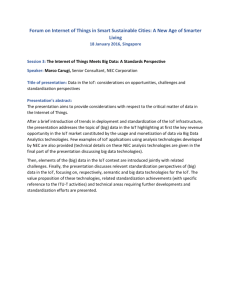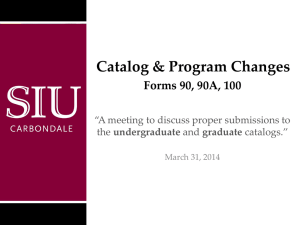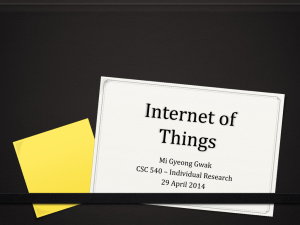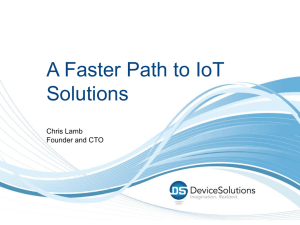Karl Schoer, SSG Wiesbaden - CIRCABC
advertisement
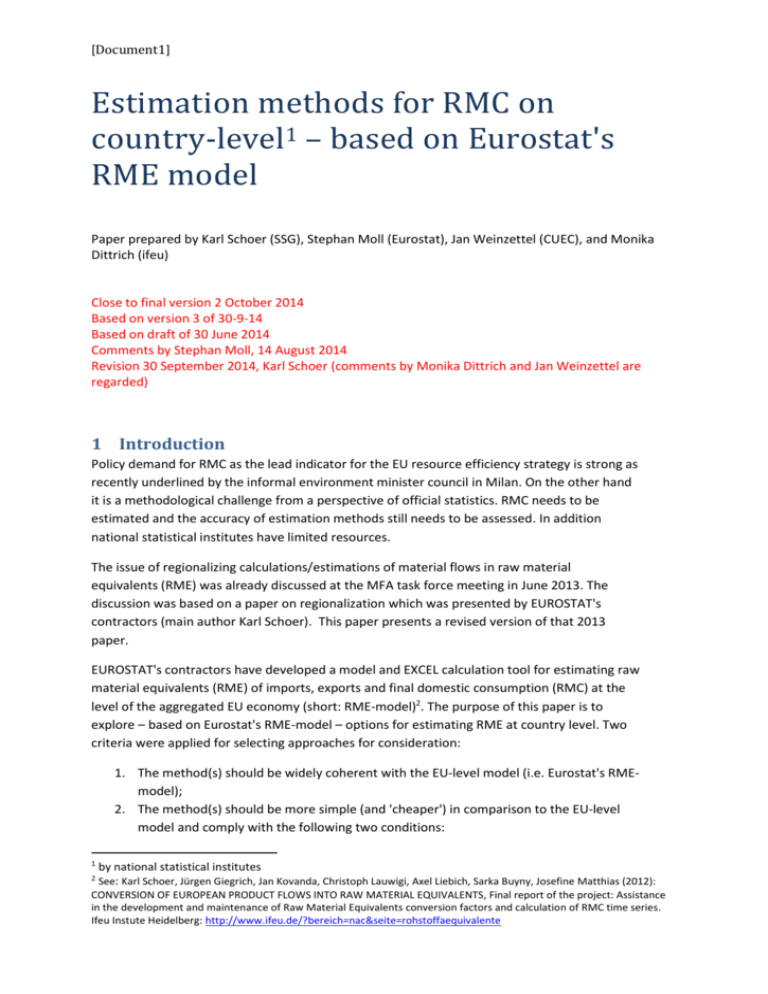
[Document1]
Estimation methods for RMC on
country-level1 – based on Eurostat's
RME model
Paper prepared by Karl Schoer (SSG), Stephan Moll (Eurostat), Jan Weinzettel (CUEC), and Monika
Dittrich (ifeu)
Close to final version 2 October 2014
Based on version 3 of 30-9-14
Based on draft of 30 June 2014
Comments by Stephan Moll, 14 August 2014
Revision 30 September 2014, Karl Schoer (comments by Monika Dittrich and Jan Weinzettel are
regarded)
1 Introduction
Policy demand for RMC as the lead indicator for the EU resource efficiency strategy is strong as
recently underlined by the informal environment minister council in Milan. On the other hand
it is a methodological challenge from a perspective of official statistics. RMC needs to be
estimated and the accuracy of estimation methods still needs to be assessed. In addition
national statistical institutes have limited resources.
The issue of regionalizing calculations/estimations of material flows in raw material
equivalents (RME) was already discussed at the MFA task force meeting in June 2013. The
discussion was based on a paper on regionalization which was presented by EUROSTAT's
contractors (main author Karl Schoer). This paper presents a revised version of that 2013
paper.
EUROSTAT's contractors have developed a model and EXCEL calculation tool for estimating raw
material equivalents (RME) of imports, exports and final domestic consumption (RMC) at the
level of the aggregated EU economy (short: RME-model)2. The purpose of this paper is to
explore – based on Eurostat's RME-model – options for estimating RME at country level. Two
criteria were applied for selecting approaches for consideration:
1. The method(s) should be widely coherent with the EU-level model (i.e. Eurostat's RMEmodel);
2. The method(s) should be more simple (and 'cheaper') in comparison to the EU-level
model and comply with the following two conditions:
1
2
by national statistical institutes
See: Karl Schoer, Jürgen Giegrich, Jan Kovanda, Christoph Lauwigi, Axel Liebich, Sarka Buyny, Josefine Matthias (2012):
CONVERSION OF EUROPEAN PRODUCT FLOWS INTO RAW MATERIAL EQUIVALENTS, Final report of the project: Assistance
in the development and maintenance of Raw Material Equivalents conversion factors and calculation of RMC time series.
Ifeu Instute Heidelberg: http://www.ifeu.de/?bereich=nac&seite=rohstoffaequivalente
a) deliver a sufficient degree of accuracy of the results, and
b) be feasible (e.g. in terms of data requirements) with comparably low resources (e.g.
workload and costs) at the level of national statistical institutes.
The general approach of this paper is to compare the results of different simplified RME
calculation methods (called options) with the results of a so-called reference approach
(benchmarking). The reference approach is represented by Eurostat's RME model for the EU27 and for Germany by results generated with the Eurostat RME-model adjusted to German
data. Both reference models estimate RME through a Leontief-type of Input-Output calculation
procedure with a hybrid Input-Output Table (IOT) with 166x166 product groups (HIOT166)
which is extended by an environmental extension matrix including
(a) domestic extraction used (DEU) from Eurostat's EW-MFA data base3, and
(b) some external multi-regional information for selected products (metals, oil and gas).
Germany was selected as pilot country for data reasons, as a disaggregated monetary IOT
(MIOT166) for the year 2000 had already been established for Germany as an interim step for
compiling a EU-level MIOT166. The German monetary MIOT166 had only to be amended by
some physical sales structures in order to obtain a HIOT166 which methodically corresponds to
EU level HIOT 166.
This paper presents and evaluates 7 options for RME-estimates on country level. The first
option is a so-called coefficient approach. Options 2, 3 and 4 are LEONTIEF-type Input-Output
approaches. Options 5, 6 and 7 are "mixed approaches" seeking for advantages of both
approaches.
All 7 options have in common that the RME of imports is estimated using the so-called
coefficient approach. This is presented in chapter 2.
The 7 options only differ in the way they estimate RME of final used products including
exports. This is explained in chapter 3. All approaches are based on Leontief-type calculations
in the one or the other way using the same data on DEU (Eurostat's EW-MFA database).
Chapter 4 evaluates the results; chapter 5 explores possible applications before chapter 6
presents some conclusions and next steps.
2 RME of imports
As far as the RME of imports are concerned, the results for all 7 options are calculated by the
so called “coefficient approach”. National import vectors in monetary and physical units are
multiplied with EU-average RME-coefficients which come in (1) tonnes RME per EUR, (2)
tonnes RME per tonne mass weight, or (3) tonnes RME per tonne oil equivalent of imported
3
As for the EU-level model, for the purpose of this paper and extended classification for DEU was applied
which shows some more details for metals.
2
energy carriers. At EU-level the results of the coefficient approach are by definition identical
with the reference approach as the RME-model is used to derive the average RME coefficients.
Two types of RME-coefficients are derived from Eurostat's RME-model results:
a) RME-coefficients for imports (extra-trade);
b) RME-coefficients for exports (extra-trade).
To obtain RME-coefficients for imports the modelling results for RME of imports by 166
product groups are simply divided by a hybrid import vector (166). This hybrid import vector
carries predominantly COMEXT foreign trade data in monetary or physical units. For those
product groups for which no foreign trade statistics (COMEXT )are available, namely services,
the data stem from the standard 60 x 60 monetary IOT (MIOT60). Energy statistics are used for
the import of energy products.
Actually two hybrid import vectors are needed on country level:
a) a hybrid extra-EU-import vector, and
b) a hybrid intra-EU-import vector.
The RME-coefficients for exports are calculated in an analogous manner as the RMEcoefficients for imports.
It has to be noted that the composition (classification or delineation of the 166 product
groups) of the hybrid trade vectors was revised in comparison to the previous version of this
paper with the objective of simplifying the calculation procedure. That is, those RMEcoefficients which are currently provided at the EUROSTAT website4 cannot be used for the
model which is described in this paper. But methodically harmonized coefficients could be
made available.
For estimating the country specific RME of imports two calculations are done5:
a) the hybrid extra-EU-import vector is multiplied with the RME-coefficients for imports;
b) the hybrid intra-EU-import vector is multiplied with the RME-coefficients for exports.
That approach implies that the RME-coefficients for extra-EU-imports at country level are identical
with the average coefficients of EU imports from non-EU countries. The latter reflect the average
production conditions of non-EU countries. Regarding intra-EU-imports it is assumed that the EU
average production technology is valid for the respective EU trade partners.
4
http://epp.eurostat.ec.europa.eu/portal/page/portal/environmental_accounts/documents/RME%20project%2
0_Introduction.pdf
5
It has to be noted that for the purpose of this calculations no country specific quality check of the external
trade data could be made, like taking into account certain miss-assignment regarding country of origin
(“Rotterdam effect”) and other errors (gold seems to be quite a problem). Also by using COMEXT and energy
balance data implicitly the territory principle instead of the residence principle was applied (implicit
assumption: the material consumption of non-residence on the domestic territory is equal to the consumption
of material of residents on non-domestic territory. However the difference may be highly relevant for some
countries (e.g. Denmark).
3
Those hypotheses of equal coefficients at EU and country levels seem not very problematic, as the
calculation is conducted at a rather detailed breakdown by 166 product groups. At least all structural
effects down to the 166 level of disaggregation are taken into consideration. Therefore it can be
considered that estimating the RME of imports at country level by that coefficient approach is most
likely able to provide the best possible and harmonized results.
3 RME of exports – concepts and calculation approaches for 7
estimation methods (options)
Unlike for imports it is questionable whether the average RME-coefficient for exports is likely to work
well for estimating RME of exports, as EU level RME-coefficients for exports are reflecting the EU
average production technology for each product group, but not necessarily the country specific
conditions. To give an example, the share of fossil energy carriers for electricity production which is
nearly 60 % for total EU differs considerably between member countries, ranging from a share of 90100 % for countries like Czech Republic down to 10% or less for France and Sweden. Therefore a set
of further options was investigated for estimating RME of exports taking into account country
specific conditions.
Technically the estimates for RME of imports (coefficient approach) and RME of exports by different
models (see options 1 to 7) are conducted by an annual uniform EXCEL based procedure. For the
purpose of that fully automated procedure only a limited number of input data (COMEXT in
monetary and physical units, national IOT in the EUROSTAT standard format, Energy Statistics, EWMFA, and Structural Business Statistics) have to be derived from EUROBASE for estimating results for
a specific country or a specific year. The country level estimates are generated in a breakdown by
intra-EU and extra-EU trade in order to allow for aggregation of regional results.
3.1 Option 0: reference approach
Concept: The reference approach for the aggregated EU-27 is identical with the results of the original
full calculation model (Eurostat's RME-model). For estimating the RME by the German reference
approach two elements are applied: Firstly, for the import side of the reference approach as for all
other options under consideration, the RME are estimated by the coefficient method based on EUlevel results. Secondly, the estimate for RME of exports is based on Leontief calculation with a hybrid
IOT with comparatively high resolution of 166x166 product groups (HIOT166) for Germany. That IOT
matrix conceptually fully corresponds with the IOT matrix which is used for the EU RME-model.
Results of the reference approach for Germany are currently only available for 2000. Therefore all
other calculations which are presented in this paper also refer to that year. The results of the
German calculation model are used as reference figures, as it is considered that this approach is likely
to provide the most accurate results.
For the estimation of RME of exports 7 different calculation approaches (options) are tested, the so
called coefficient approach, three types of IOT based calculation models and three mixed approaches
which combine elements of the IOT method with elements of the coefficient approach.
4
Compilation: The data requirement for establishing that type of disaggregated German IOT is rather
high. However for Germany very detailed supply and use tables (120 x 3000 product groups) and
some other sources (e.g. IOT for intra agricultural flows by more than 40 agricultural product groups)
could be utilized for compiling a disaggregated IOT.
3.2
Option 1: coefficient approach
Concept: For EU-27 the results of the coefficient approach are identical with the original results of
the RME model.
At country level RME of exports are estimated by the same method as the imports, i.e. the national
hybrid export vector (intra-EU and extra-EU) is multiplied by the average RME-coefficients for
exports as derived from Eurostat's RME-model.
The coefficient approach has the advantage of using a rather detailed breakdown of RME-coefficients
by 166 product groups. But on the other hand the accuracy of the results on RME of exports of
option 1 can be impaired as this approach implicitly assumes the following:
1. The national production conditions are well represented by the average EU-level conditions.
2. The structure/composition within a product group is identical with the average EU-level
structure/composition.
That is in technical terms, differences in the raw material intensities (embodied raw materials per
unit of export) at the level of 166 product groups between EU-27 and the individual countries are not
regarded by the coefficient approach (structural effect).
Compilation: The data requirement for the coefficient approach (option 1) is comparatively low, as
only country specific hybrid export vectors are required which can be derived from national foreign
trade statistics, the national MIOT60, and national energy statistics (or comparable Eurobase data).
3.3
Option 2: MIOT60
Concept: The estimate for RME of exports by option 2 is based on a Leontief-type Input-Output
calculation with the standard monetary IOT with 60x60 product groups (MIOT60)6.
Applying a country MIOT for the estimation of RME of exports has the advantage that country
specific information of production technology is utilized. But with respect to RME accounting it has to
be taken into account that the relatively low level of resolution of the standard 60x60 MIOT could
constitute a problem. The material harvesting and extracting industries (e.g. agriculture, forestry,
mining) as well as industries of primary processing of raw materials (e.g. manufacture of basic
metals) are very broadly classified in a 60x60 MIOT. The Leontief approach which is used for
estimating RME implicitly assumes that the RME intensity within a branch to produce a given product
6
The German monetary IOT which is published by the German Federal Statistical Office has the format 72x72
product groups. But for the purpose of this comparison the EU standard format of 60x60 was applied.
5
group is identical for exports and domestic use. But in reality the structure of the exports and the
domestic consumption within a product group is not necessarily identical.
That is, in technical terms, a part of the structural information of the IOT matrix is getting lost by
aggregating the IOT matrix from the level of 166 product groups to the level of 60 product groups
(structural effect). Further also information which is carried by physical use structures for some of
the product groups is neglected as well (hybridization effect).
Compilation: The additional data requirement in comparison to option 1 is comparatively low, as
only the complete regularly available national standard MIOT60 and the national EW-MFA data on
DEU are needed. However it has to be noted that the national MIOTs (published by Eurostat) do not
fully comply with the Eurostat standard format for a number of smaller countries. In some national
MIOTs the row for “Other mining and quarrying products” is aggregated with the row for “Mining of
metals ores”. The aggregated result is presented under the heading “Mining of metal ores”. These
IOTs are not suitable for doing meaningful calculations by the MIOT60 approach (option 2). Therefore
it is necessary to disaggregate those MIOTs to the EU standard format7.
3.4 Option 3: HIOT60
Concept: Option 3 differs from option 2 by using a partly hybridised IOT (HIOT60) instead of a purely
monetary IOT (MIOT60). In order to keep it simple the partly hybrid IOT is established by replacing
the monetary sales structure only for “Other mining and quarrying” by a physical one8. Hybridisation
can be a way to attenuate the adverse effect of too low (i.e. aggregated, coarse) resolution of the IOT
matrix as it is capable to neutralise structural effects which arise if the unit values for sub-product
groups differ significantly. That effect is expected to be relevant for the selected product group.
Using an aggregated monetary sales structure for non-metallic minerals (“other mining and
quarrying” products) it is likely to cause miss-allocations of material between domestic use and
exports. Also the allocation within the economy is considerably effected by structural effects.
Non-metallic minerals include two principal material categories, so-called “industrial minerals” and
“construction minerals. The typical use-structure of those two material categories is rather different.
Roughly “industrial minerals”, like quartz sands, salt, “other mining and quarrying products n.e.c.”
are used by non-construction activities and for exports whereas construction sands and clay and
most of limestone are used for manufacturing construction materials or are directly used by
domestic construction activities. Further the unit values (EUR/kg) of those materials differ
considerably. Therefore the highly aggregated monetary sales structure for aggregated non-metallic
minerals of the MIOT60 is not sufficiently reflecting the allocation of the material in physical terms.
Generally the use of low priced construction materials for construction purposes is heavily
underreported by that type of aggregated monetary sales structure.
7
For the reference years after 2008 the A*64 level of the NACE Rev2 classification is employed in the European
Statistical System (MIOT64). This level considers only one aggregated mining industry which is not suited for
Leontief-type re-allocations of material flows. A solution could be to apply a disaggregation approach for
mining as presented und option 4 for metals.
8
In the previous paper some more hybrid sales structures where introduced. However it can be shown that
applying those additional physical sales structures are not likely to change the results in a significant manner, at
least as results for Germany are concerned.
6
In technical terms the structural and the hybridization effect of shifting from HIOT166 to MIOT60 is
at least partly compensated for non-metallic minerals if option 3 is applied.
Compilation: The HIOT60 approach (option 3) requires the estimation/derivation of country specific
physical sales structures for non-metallic minerals leading to the following sequence of compilation
steps:
1. In a first step an aggregated physical sales structure for non-metallic minerals is estimated at
EU level which is based on disaggregated physical structures of the HIOT166.
2. EU average coefficients by branches are calculated by dividing the physical vector by the
corresponding monetary vector.
3. In a third step raw values at country level are calculated by multiplying the country specific
monetary sales structure by the vector of EU-level coefficients (kg/EUR) derived in step 2.
4. In a fourth step those raw values are adjusted to the total domestic use of non-metallic
minerals (output + imports – exports) in tonnes.
The additional data requirement for option 3 is low. For all single country calculation the same EUlevel coefficient vector is needed. The required country specific benchmark values are obtained from
COMEXT (imports and exports in tonnes) and EW-MFA (domestic extraction/output in tonnes).
3.5 Option 4: Disaggregated IOT for metals (HIOT66)
Concept: The fourth option employs a slightly more disaggregated HIOT with additional details in
metal processing. The RME-coefficients for metal ores (t RME/EUR) depend on and vary considerably
across metals (e.g. gold versus iron). Those differences are even more pronounced than for the RME
of non-metallic minerals. Therefore it can be expected that structural effects within the metal
production branches (metal ores and basic metals) can have considerable impacts on the assignment
of RME to the exports of metal products ( especially for basic metal products; whereas the effect for
metal ores might be rather negligible because of the low quantities of metal ore exports). In order to
compensate for that effect a moderate disaggregation of the IOT matrix from 60 to 66 branches is
introduced by option 4. For the purpose of option 4 the physical metal ore inputs to the economy
where directly assigned to the corresponding basic metal producing branches and not to the
extracting branches. This has the effect that the metal ore inputs into the economy are regarding by
the same level of disaggregation as the basic metal branch.
The disaggregation is done for the product group “basic metals” which is divided into the sub-groups
(1) “iron”, (2) “precious metals”, (3) “aluminium”, (4) “lead, zinc, tin”, (5) “copper”, (6) “other nonferrous metals”, and (7) “casting services”.
In technical terms the structural effect of shifting from HIOT166 to MIOT60 is at least partly
compensated for raw material category metal ores by introducing option 4.
Compilation: The column and row for "basic metals" in the HIOT60 needs to be disaggregated into 7
columns and rows respectively. In a first step the column total of "basic metals", i.e. the total inputs
into the basic metal industry, is disaggregated in to 7 column totals using structural business statistics
(SBS). The row totals for "basic metals ", i.e. exports, imports, output are disaggregated by
7
employing SBS, and trade statistics (e.g. COMEXT). In a second step the new columns and rows are
populated based on structural information from the EU-level MIOT166. The structural information is
adjusted to the benchmark values of the HMIOT60 and the expanded row and column totals by an
iterative RAS approach9.
The additional data requirement for this option compared to option 3 is confined to SBS data for
basic metals on “production value” and “total purchases of goods and services” and foreign trade
statistics for imports and exports. It has to be noted that for some countries gap filling is required in
cases of suppressed values, by acquiring confidential values or through auxiliary data sources, like
physical quantities and metal prices from USGS.
3.6 Option 5: Mixed IOT-coefficient approach for raw products
Concept: The general rationale for a “mixed approach” – combining the IOT approach with the
coefficient approach – is to try to make advantages of both principal approaches, the high resolution
by product groups of the coefficient approach and the country specific information on production
technology of the IOT approach. Therefore the three “mixed approaches” which are presented in this
paper combine elements of the coefficient approach (option 1) and of the IOT approach with HIOT66
(option 4).
Option 5 estimates the RME of exports for all raw products (products from extraction of raw
materials) by employing the coefficient approach. The estimation for all other products is based on
Leontief-type calculations with HIOT66.
For the purpose of this model the following product groups are assigned to the category of raw
products ('old' CPA2002 classification): CPA 01 (“Products of agriculture, hunting and related
service”) to CPA 14 (“Other mining and quarrying products”).
Extraction of raw materials belongs to the lower end of the production chain. This holds to some
extent also for the branches of primary processing of raw materials (see options 6 and 7 below).
Option 5 assumes that the production technology for extracting raw materials is likely to be similar
with respect to the RME coefficients for all EU countries if a high resolution level by 166 products
groups is applied. AT the same time option 5 considers that the technology tends to be more
different for product groups which belong to the upper end of the production chain. It has to be
stressed that the term “technology” is not only denoting differences in technology in the strict sense,
but may reflect predominantly structural effects at the level of a 66x66 IOT.
The coefficient approach is not applied for energy resources. An assessment of advantages and
disadvantages of a 60x60 IOT matrix (low resolution, but country specific information) compared to
the coefficient approach (high resolution, but no country specific information) tends to be in favour
of estimating the embodied energy resources by the IOT approach also for option 5 for the following
reasons:
9
Karl Schoer et al. (2012), p 21
8
1. The flow of energy carriers through the economy is comparatively well depicted at the level
of the 60x60 IOT level (four product groups). Especially the transformation of primary energy
carriers into secondary energy (oil products and electricity) is well described.
2. The use of energy carriers for non-transformation purposed is widely scattered over the
whole economy. Therefore, assignment errors due to the low resolution of the IOT are likely
to compensate each other to a certain extent
Compilation: For conducting option 5 only the Leontief calculation procedure has to be technically
adjusted. For product groups estimated with the coefficient approach the results of the IOT approach
are replaced by results from the coefficient approach. The results for final domestic use are adjusted
accordingly. The raw material category energy resources is exempted from that replacement No
additional data are required for this option.
3.7 Option 6 Mixed IOT-coefficient approach for raw products and
products from primary processing of raw materials (excluding basic
metals)
Concept: Option 6 differs from option 5 by extending the coefficient approach to all products of
“primary processing of raw materials”. Only the results for basic metals are still taken from the IOT
approach.
Products from “primary processing of raw materials” include for the purpose of this paper “food”,
“tobacco”, “leather”, “wood”, “pulp and paper”, “coke, refined petroleum products and nuclear
fuels”, “other non-metallic mineral products”, and “electricity.
As for the purpose of option 5, the coefficient approach is not applied for energy resources.
Excluding energy resources is even more important for products of primary processing, as the energy
mix of electricity generation differs considerably between member countries, e.g. France, Sweden,
Finland with a very low share of fossil energy carriers for electricity production and the Czech
Republic with a share considerably above average. That is, the embodied fossil energy of direct
electricity exports is not well represented by the EU average, as assumed by the coefficient
approach. Moreover, electricity is also embodied to a considerable extent in exports (indirect
electricity exports) of products of primary processing, i.e. also for those products the national energy
mix of electricity generation can matter considerably.
Compilation: The calculation method follows the approach as described under option 5. No
additional data is required for this model.
3.8 Option 7 Mixed IOT-coefficient approach for raw products and all
products from primary processing of raw materials
Concept: In comparison to option 6 also the RME of exports of basic metals are estimated by the
coefficient approach. For the purpose of option 7 no special treatment (as for options 5 and 6) was
applied for energy resources.
9
Compilation: The calculation method follows the approach as described under options 5 and 6. No
additional data is required for this model.
4
RME of exports – comparing and evaluating results
In this section the results of the 7 calculation approaches under investigation (options) are compared
for Germany, EU-27 and selected aggregated EU member countries which together account for
nearly 90% of all RME of exports. Results are compared with the aim of assessing the suitability of
the various approaches for regionalised RME estimates.
Compared at the conceptual level the various approaches have advantages and disadvantages.
Within the family of IOT approaches it can be expected that the more sophisticated approaches
provide more accurate results. The “mixed approaches” try to exploit the advantages of both
concepts.
Summarized results for the different approaches (options) are presented in Table 1.
Table 1
Comparison of options for estimating RME of Exports
2000
DEU
EXP
IMP
Opt 0
Opt 1
Reference Coeficient
approach approach
Opt 2
MIOT60
Opt 3
HIOT60
Opt 4
Opt 5
HIOT65
HIOT66/
(basic
coefficient
metals
approach
disaggrega
for all
ted)
extraction
(excl.
energy
resources)
Opt 6
Opt 7
HIOT66/
HIOT65/
coefficient coefficient
approach
approach
for all
for all
extraction
extraction
and primary and primary
processing processing
(excl energy
resources
and basic
metals)
RMC
based on
Opt 6
DE (intra and extra trade)
Total
Biomass
1,205
245
1,265
145
882
116
1,083
147
964
91
850
91
876
93
886
103
899
130
957
130
1,571
260
0
413
278
372
274
274
290
291
293
342
121
Non-metallic minerals
739
203
182
231
330
217
220
219
203
204
738
Fossil energy carriers
221
505
306
333
269
268
273
273
273
280
452
1,516
229
427
360
500
1,630
235
518
362
515
1,613
217
518
363
515
1,610
228
518
349
515
1,700
228
623
346
504
8,041
1,702
714
3,634
1,991
1,583
199
622
301
460
1,567
199
605
297
466
7,241
1,394
840
3,119
1,888
Metal ores
EU-27 (extra trade)
Total
Biomass
Metal ores
Non-metallic minerals
Fossil energy carriers
6,515
1,688
136
3,661
1,029
Total
Biomass
Metal ores
Non-metallic minerals
Fossil energy carriers
5,410
1,364
76
3,159
811
3,136
241
1,096
322
1,476
1,726
224
626
315
562
1,726
224
626
315
562
2,422
229
428
1,263
503
DE, AT, BE, CZ, DK, EL, ES, FR, FI, HU, IT, NL, RO, SE, UK (extra trade)
2,920
225
1,041
300
1,354
1,605
204
596
291
514
1,734
194
473
615
452
1,415
194
473
298
451
1,577
198
621
298
460
1,567
187
621
299
460
4.1 Germany
The results for Germany allow for both, a comparison of the results of the different models with the
reference approach (what is the accuracy in comparison to the “best possible option”?) and a
10
comparison between the different models (what is the quantitative contribution of introducing more
sophisticated options?).
The total RME of exports for Germany as estimated by option 1 amount to 1083 Mio tonnes, which is
23 % higher than the reference approach. The relative differences are more pronounced at the level
of main raw material categories, except for fossil energy carriers which show a comparatively good
match (+8%). Those considerable gaps indicate that there are significant differences in raw material
intensities (intensity effect) between EU and DE. Those differences are neglected by applying option
1.
Compared to that, option 2 shows an improvement as far as the total RME of exports is concerned.
The total RME of exports by this model comes to 964 Mio tonnes, which is 9% higher than the
reference approach but much lower than the result for option 1. But at the level of main raw
material categories there are still significant differences to the reference approach which range
between +81 and -21 %. Those results reveal significant structural effects which go, except for nonmetallic minerals in the opposite direction than the efficiency effects.
Using a HIOT60 (option 3) instead of a MIOT60 improves the accuracy of the calculation for nonmetallic minerals significantly by reducing the hybridization effect for non-metallic minerals.
The impact on the results of introducing option 4 (HIOT66) which is intended to reduce the structural
effect is rather low for Germany whereas applying the mixed approach of option 5 is able to improve
the match with the reference approach considerably. The results for the total RME of exports are
close to the reference approach, but there are still some differences at the level of main raw material
categories.
Using option 6 is further improving the match with the reference approach at the level of main raw
material categories. The differences to the reference model are as follows:
Total
2%
Biomass
12%
Metal ores
5%
Non-metallic minerals 12%
Fossil energy carriers -11%
Against that by introducing option 7 the match with the reference approach is deteriorating,
especially for metal ores.
As a preliminary conclusion based on calculation results for Germany it can be stated that the degree
of accuracy which can be achieved by option 6 is not perfect, but the results are showing the best
match in comparison to the reference approach.
4.2 EU-27
Calculation results at EU-level allow, as for Germany, for both, a comparison of the results of the
different models with the reference approach as well as a comparison between the different models.
However, as the results of the coefficient approach are identical by definition with the reference
11
approach it is not possible to assess the quality of the coefficient approach itself and of the mixed
approaches, which carry considerable information from the coefficient approach. Those noninterpretable results are marked by grey typeface in the table.
At the level of EU-27 the calculation results option 4 shows the best match with the reference
approach. Option 2 (MIOT60) differ considerably from the reference approach (+40 %). The highest
difference can be observes for non-metallic minerals.
A considerable improvement of the match with the reference approach can be achieved for nonmetallic minerals (360 Mio t instead of 1263 Mio t) by applying option 3 (HIOT60). But with respect
to total RME of exports option 3 shows a considerable underreporting (-12%).
Introducing option 4 (HIOT66) is improving the match for metal ore considerably (-17% compared to
-32%). As a result the overall difference comes down to -6%.
The results suggest that option 4 provides the best results, but the degree of accuracy which can be
obtained by option 4 alone might not be sufficient.
4.3 Aggregated member countries
The available calculation procedure was also applied for generating results for additional 14 member
countries which are representing together (including Germany) about 93% of all EU-level RME10.
As the coverage by the selected countries is very high, it was possible to analyse aggregated results
of those countries. This paper is only presenting and investigating those aggregated data. Data for
individual countries should be analysed later.
For the “aggregated country results” no direct reference approach is available. However it has to be
regarded that conceptually the aggregated result of option 1 (coefficient approach) for all EUmember countries should be identical with the results of the coefficient approach for the EU-27 level,
which again is identical with the EU-level reference approach. Therefore the results of the
aggregated coefficient approach for the selected countries could be taken as a proxy for a reference
approach.
For the aggregated countries the comparison of the result of options 2 to 4 with the proxy reference
approach of option 1 show in principle a similar pattern as the EU-27 results.
The total RME of exports by option 4 are only 2% below the level of the reference approach.
The differences are as follows:
Total
-2%
Biomass
-3%
10
For calculating results for individual countries based on EUROBASE data some gap-filling was necessary for
data from Structural Business Statistics (SBS) mainly due to values which are suppressed for confidentiality
reasons. Further the IOT for some countries did not fully comply with the EUROSTAT format. Mainly rows for
mining where aggregated. In one case the use structures for mining products turned out to be highly
implausible. In all those cases it was not possible to generate meaningful results by IOT based models. A
solution for those countries could be to fall back to the coefficient approach (option 1).
12
Metal ores
4%
Non-metallic minerals 2%
Fossil energy carriers -10%
It is remarkable that the match of the results of option 4 with the reference approach is much better
than for the corresponding results from the direct calculation at EU-27 level In this connection it has
to be pointed out that the aggregated results of the simplified models of options 2 to 7 from
estimates for member countries should tend to be more accurate than the corresponding results
which were generated directly at EU level. The reason is that more detailed regional information is
used11.
As far as the interpretation of the results of the mixed approaches are concerned, the same
limitations which are valid for total EU model are also valid for the model based aggregated country
results therefore the typeface of the cells with results of options 5 to 7 is also marked with grey
colour.
5
Applications
As an application decomposition analysis12 could be applied either for a specific year (comparison
between countries), as comparison over time for individual countries or as a combination of both.
The principal approach of decomposition analysis is to isolate the following influencing effects on
material consumption: scale, structure and efficiency.
That analysis can be conducted for individual or for aggregated raw material categories.
It could be useful to define the scale effect as per capita material consumption per unit of final
domestic use.
Preferably option 6 should be applied. That is, the decomposition can be based on the standard
MIOT60 disaggregation. For country comparison the EU 27 relationships can be used as a reference
approach (instead of a base year).
11
The effects of sectoral and regional disaggregation are complementary to some extent. A high level of
sectoral disaggregation (e.g. 166 product groups) is able to assign the extracted raw materials rather precisely
to the exported products. In that case further regional disaggregation may contribute only little towards
improving the accuracy of the results. However with low sectoral disaggregation (60 product groups) the
assignment of raw materials to exported products tends to be rather imprecise. To give an example: the
extraction and the import of gold (high priced) and iron (comparatively low priced) are put together in one
branch in 60x60 IOT (basic metals). As a result the embodied gold and iron ores of all metal containing exports
reflect the share at the supply of both metals. Let us assume that the whole region consists of two countries,
one country is specialized in gold ore extraction and export of gold products and the other is specialised in
extraction of iron ores and export of iron products. If the total IOT is split into two country IOTs the IOT model
will provide a much more precise assignment of gold and iron ores to exported products. Insofar it can be
stated that especially with a low level of sectoral aggregation of the IOT additional regional disaggregation
could be able to improve the accuracy of the results.
12
See Schoer et al (2012), pp78
13
6
Conclusions and next steps
This paper compares 7 different simplified options for estimating RME of exports at country level.
Options no. 6 turned out to be the most suitable one if compared with the results of the full model
(reference approaches).
The issue needs some further investigation with respect to individual country results.
If feasible Eurostat intends to compare the various estimation approaches for country-level estimates
(options 1 to 7) with results from multi-regional input-output modelling (e.g. CREEA13).
13
From a pure conceptual point of view, multi-regional Input-Output (MRIO) approaches like the CREEA approach are
capable of estimating embodied emissions of imports which perfectly reflect the production conditions in the countries of
origin. However to what extent that conceptual advantage is effectual depends on the resolution and the data quality of
the MRIO model. Those models are based on mass data harvest from various national and international data bases of
different quality. It can be doubted that the currently existing models are able to estimate a world-wide IOT matrix with a
sufficient degree of accuracy. See: Karl Schoer, Richard Wood, Iñaki Arto and Jan Weinzettel (2013): Estimating Raw
Material Equivalents on a Macro-Level: Comparison of Multi-Regional Input−Output Analysis and Hybrid LCI-IO,
Environmental Science & Technology
14



